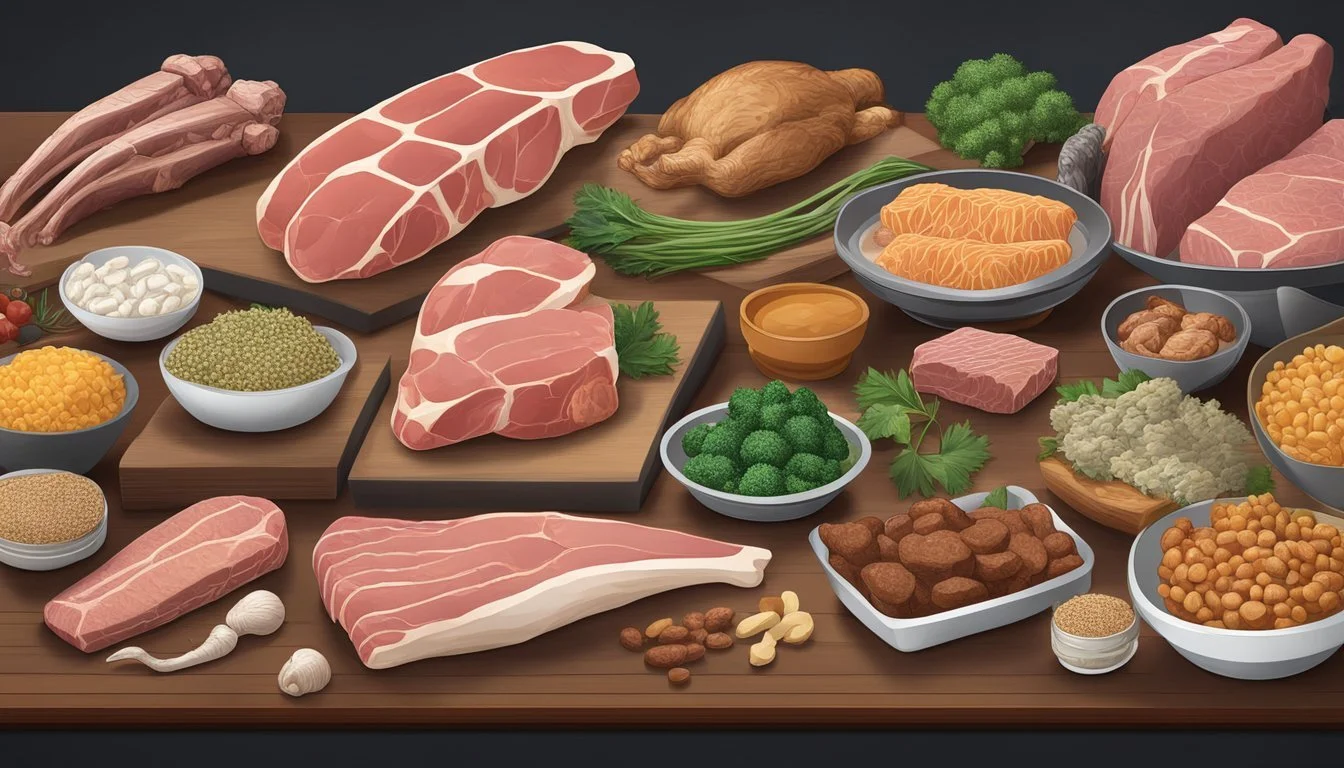How to Discover New Animal-Based Foods
Expanding Your Carnivore Diet Options
Engaging with a carnivore diet can offer a straightforward approach to nutrition, emphasizing animal-based foods, including both meats and animal products. This dietary lifestyle is preferred by some for its health benefits, as it focuses on nutrient-dense, natural foods that provide essential proteins, fats, vitamins, and minerals. Advocates often cite increased energy, weight loss, and improved digestion among the potential positive outcomes of adopting this way of eating.
However, sticking to a diet consisting solely of animal products can sometimes lead to a lack of variety, which is why some individuals seek to expand their culinary horizons within this dietary framework. By exploring a diverse range of animal-based foods beyond conventional muscle meats, individuals following a carnivore diet can enhance their meal plans. This includes delving into less common cuts of meat, organ meats, certain dairy products, and even incorporating some animal-based fats, thus ensuring a greater array of nutrients and flavors.
To maintain interest and ensure a well-rounded intake of nutrients, those on a carnivore diet can aim to include a spectrum of animal-based options. Introducing a variety of meats such as grass-fed beef, fatty fish rich in omega-3s, and pasture-raised poultry can make meals more enjoyable and nutritionally complete. Additionally, turning to eggs and low-lactose, full-fat dairy products can provide both variety and valuable nutritional content. Through thoughtful selection of animal-based foods, individuals can pursue a carnivore diet that supports their health goals while keeping their meals interesting and varied.
Basics of the Carnivore Diet
Exploring the Carnivore diet reveals a regimen centered on animal products focused on protein and fat consumption, with meat as the dietary staple.
What Is the Carnivore Diet?
The Carnivore diet is a nutritional plan that consists exclusively of animal products and byproducts. It excludes all forms of plants and plant-derived substances. This diet is often characterized by its simplicity and restriction to a single food group – animal-based foods. Individuals who follow this diet consume a high amount of animal protein and fats, while carbohydrate intake is minimal or nonexistent.
Primary Foods in a Carnivore Diet
Primary food sources in a Carnivore diet include:
Meat: Such as beef, lamb, pork, and chicken
Fish: Emphasizing nutrient-dense, fatty varieties like salmon
Organ meats: Highly nutritious, including liver and kidney
Eggs: A complete protein source
Dairy: Mostly full-fat versions like butter and hard cheeses
Individuals on the diet may vary their intake to include a mixture of these foods, often aiming to consume different types to avoid nutrient deficiencies.
Understanding Nutrients and Macros
On the Carnivore diet, the macronutrient distribution is heavily weighted towards proteins and fats. Carbohydrates are virtually absent from this dietary approach. Here's a simplified breakdown:
Protein: Essential for muscle growth and repair, sourced from all animal meats and eggs.
Fat: Serves as the primary energy source, obtained from cuts of meat with higher fat content and full-fat dairy.
Carbohydrates: Typically not considered part of the diet, as it focuses on animal products, which are naturally low in carbs.
Nutrient intake should be monitored, especially when it comes to vitamins and minerals that are less abundant in animal foods, ensuring a balanced approach to the Carnivore diet for optimal health.
Exploring Diverse Meat Options
In the pursuit of variety within the carnivore diet, individuals are encouraged to investigate different sources of meat to satisfy nutritional needs and palate preferences. Embracing a diverse selection of animal-based foods ensures a broad spectrum of nutrients and can offer new culinary experiences.
Beyond Beef and Chicken
While beef and chicken are staples in many carnivore diets, exploring other types of poultry such as duck or turkey broadens the spectrum of flavors and textures. Lamb and pork are also excellent alternatives that offer a variety of cuts suitable for multiple cooking methods. Here are some examples:
Poultry: Duck, Turkey, Quail
Lamb: Chops, Leg, Shank
Pork: Belly, Shoulder, Loin
Seafood Varieties
Seafood is a category rich with diversity, providing different flavors, textures, and nutrients. From fatty fish rich in omega-3 fatty acids to leaner white fish (What wine goes well with white fish?), incorporating seafood can be a beneficial practice. Shellfish, (What wine goes well with shellfish?) such as oysters and mussels, (What wine goes well with mussels?) contain unique nutrients not typically found in land animals. Common options include:
Fatty Fish: Salmon, Mackerel, Sardines
White Fish: Cod, Halibut, Bass
Shellfish: Shrimp, Clams (What wine goes well with clams?), Scallops (What wine goes well with scallops?)
Game Meats and Exotic Choices
For those with adventurous tastes, game meats offer an alternative to traditional livestock and a way to experience different flavors and textures. Game meats like venison (What wine goes well with venison?), bison (What wine goes well with bison?), and elk are often leaner and can be a source of grass-fed red meat. Exotic choices might include meats like kangaroo or ostrich*, though availability varies by region. Consider these game options:
Game Meats: Venison, Bison, Elk
Exotic: Kangaroo*, Ostrich (What wine goes well with ostrich?)*
*Check local regulations and ethical sourcing practices when choosing exotic meats.
The Role of Organ Meats
Organ meats are a treasure trove of nutrients within an animal-based carnivore diet. They offer a concentrated source of vitamins and minerals essential for maintaining optimal health.
Nutritional Benefits of Liver and Kidney
Liver is one of the most nutrient-dense organs, rich in vitamin A, several B vitamins, including B12, iron, and coenzyme Q10. A 100-gram serving of beef liver provides around 6.5 times the Recommended Dietary Allowance (RDA) of vitamin A and more than 50% of the RDA for iron, making it a powerhouse for supporting overall health.
The kidney is another organ that brings nutritional value to the table. While slightly less celebrated than liver, kidneys provide substantial amounts of B vitamins, especially riboflavin and niacin, and are a good source of minerals like selenium and iron. These nutrients are vital for energy metabolism, DNA synthesis, and protecting the body against oxidative damage.
Incorporating Heart and Brain
The heart is an excellent source of coenzyme Q10, an antioxidant that plays a role in energy production and may support cardiovascular health. It's also high in protein, B vitamins, and minerals such as iron and zinc. Due to its muscle-like texture, the heart can be an easier transition for those new to eating organ meats.
The brain is less commonly consumed but provides unique benefits as it is high in omega-3 fatty acids, particularly DHA, which is essential for brain health. It also contains choline, an important nutrient for liver function and brain development. However, sourcing and handling of brain must be done with care due to potential health risks.
Dairy and Eggs in Carnivore Cuisine
Dairy and eggs offer a wealth of options to add variety and nutrition to a carnivore diet. They are versatile and can be included in different forms to keep mealtimes interesting.
Choosing the Right Dairy
When incorporating dairy into a carnivore diet, it's essential to select full-fat options for maximal nutritional benefit. Cheese and butter are excellent sources of fat and can be used in various recipes to enhance flavor. Milk can be consumed as a beverage or utilized as a base for sauces and soups. However, those who are sensitive to lactose may opt for harder cheeses and butter, as they contain lower levels of lactose.
Examples of Carnivore-Friendly Dairy:
Cheese (particularly hard cheeses like cheddar, parmesan)
Butter (preferably from grass-fed sources)
Heavy cream (useful for thickening sauces)
Always ensure the chosen dairy products are free from additives and minimally processed.
The Power of Eggs
Eggs are a powerhouse of nutrition, providing high-quality protein, vitamins, and minerals. They are incredibly adaptable and can be used to increase the protein content of meals, acting as a binding agent in recipes, or simply enjoyed on their own, cooked in various styles.
Creative Ways to Use Eggs:
Soft-boiled or hard-boiled as a portable snack
Scrambled with cheese for a nutrient-dense breakfast
As a binder in making carnivore diet-friendly 'bread'
Eggs are also an economical food choice, making them accessible to a wide range of people on a carnivore diet. Whether used as the main component of a meal or as an addition to other animal-based foods, eggs provide both flavor and a complete amino acid profile.
Fats and Oils for Cooking and Flavor
In pursuing a carnivore diet, one must pay careful attention to incorporating a variety of healthy fats for both cooking and enhancing flavor. Animal-based fats not only provide essential nutrients but also contribute a depth of flavor to meals.
Healthy Fats and Animal Lards
Beef Tallow and Bison Tallow: Both beef and bison tallow are valuable sources of saturated fats, ideal for high-heat cooking due to their high smoke points. Consumers can often source these fats from butchers or by rendering them at home. Tallow adds minimal flavor properties to dishes, making it versatile for various culinary applications.
Pork Lard: Derived from pork fat, lard is another traditional cooking fat with a history in many cultures. It has a moderate smoke point suitable for baking and frying. When selecting lard, individuals should seek out leaf lard, the highest quality, obtained from the area around the pig's kidneys.
Skip the lines and order your beef tallow or pork lard online for a stress-free shopping experience!
Butter and Ghee
Butter: As a staple in the kitchen, butter is rich in fat-soluble vitamins and provides a creamy flavor profile. It is a suitable fat source for those following an animal-based diet, especially when sourced from grass-fed cows.
Ghee: Clarified butter, or ghee, is butter that has been simmered to remove water content and milk solids. This process yields a pure butterfat with a higher smoke point than regular butter, making it an excellent choice for sautéing and other high-temperature cooking methods. Ghee also carries a nutty flavor and is lactose-free, serving as a digestible option for those with dairy sensitivities.
By carefully selecting quality fats and oils for cooking and flavoring, individuals on a carnivore diet can ensure they're receiving essential nutrients while enjoying a rich and diverse culinary experience.
I always prefer buying ghee online because of the added convenience!
Seasoning and Preparation Methods
In the carnivore diet, one’s culinary experience is highly dependent on how the meat is seasoned and prepared. While the ingredient list is minimal, the right seasonings and cooking techniques are crucial for adding variety and enjoyment to every meal.
Appropriate Seasoning Choices
When considering seasonings for the carnivore diet, one should prioritize simplicity to maintain the diet's integrity. It's crucial that they incorporate seasonings that consist of animal-based or zero-carb ingredients. Salt and pepper are fundamental components as they not only enhance the natural flavor of meats but are also compliant with the diet's guidelines.
List of Allowed Seasonings:
Salt (Himalayan, Sea Salt)
Black Pepper
Bone broth (as a base for sauces)
Animal fats (for flavor and cooking)
Using these key seasonings allows individuals to enjoy the rich, natural flavors of various meats without introducing non-animal-based additives.
Online shopping for Himalayan salt or sea salt, and black pepper is the smart choice for a seamless transaction!
Cooking Techniques for Carnivore Dieters
Utilizing a variety of cooking methods can significantly diversify one's eating experience on the carnivore diet. Techniques such as grilling, roasting, and slow-cooking not only create different textures and flavors but can also enable better digestion and nutrient absorption from the meats.
Cooking Methods Table:
Grilling
Benefit: Adds a smoky flavor, ideal for steaks
Tips: Use high heat for short times to sear meats
Roasting
Benefit: Even cooking, perfect for larger cuts
Tips: Use lower temperatures for longer periods
Slow-Cooking
Benefit: Tenders meat, good for tough cuts
Tips: Allow sufficient time for meat to become tender
Searing
Benefit: Crispy exterior while retaining moist interior
Tips: High heat for a short duration
Water can also be used in cooking methods such as boiling or poaching to maintain the moisture of meats without adding additional flavors. By varying these techniques, individuals can discover new textures and nuances in their meals, keeping their diet both interesting and enjoyable.
Enjoy the convenience of doorstep delivery when you buy electric grill or slow cooker online!
Addressing Nutritional Diversity and Supplementation
When following a carnivore diet, individuals must ensure they are receiving a full spectrum of necessary nutrients. This section outlines considerations regarding vitamins and minerals, the role of fiber and plant compounds, and the appropriate use of supplements.
Vitamin and Mineral Considerations
A well-structured carnivore diet should prioritize nutrient-dense animal foods that provide a wide array of vitamins and minerals.
Important nutrients to consider include:
Vitamins: Especially vitamins A, D, E, and K2, which are abundant in liver, butter, and egg yolks.
Minerals: Such as zinc, found in oysters and beef, and magnesium, which can be lower in muscle meats.
RMD (Required Minimum Daily) for adults:
Vitamin A
RMD (Male): 900μg
RMD (Female): 700μg
Vitamin D
RMD (Male): 15μg (600 IU)
RMD (Female): 15μg (600 IU)
Vitamin E
RMD (Male): 15mg
RMD (Female): 15mg
Vitamin K2
RMD (Male): 120μg
RMD (Female): 90μg
Zinc
RMD (Male): 11mg
RMD (Female): 8mg
Magnesium
RMD (Male): 400–420mg
RMD (Female): 310–320mg
The Debate on Fiber and Plant Compounds
The carnivore diet usually excludes fiber, as it is found in plant materials. Proponents argue that fiber is not necessary for digestive health and that the human gut can function well without it. However, there should be awareness of the potential long-term effects of fiber exclusion.
Possible benefits of fiber:
May contribute to gut health.
Can help with regular bowel movements.
While the carnivore diet excludes phytonutrients found in plants, which some consider beneficial for their antioxidant properties, animal-based foods also contain powerful antioxidants such as:
Coenzyme Q10 (in heart and liver)
Carnosine (in muscle meat)
Augmenting with Supplements
While a diverse carnivore diet can provide many nutrients, there may be a need to supplement, especially in the case of:
Electrolytes: To balance electrolytes like sodium, magnesium, and potassium.
Vitamin D: If sun exposure is insufficient, supplementation can be critical.
Omega-3 fatty acids: To ensure a proper balance with omega-6, found in grass-fed ruminant meat and fish.
Take advantage of the wide variety of online options when shopping for an electrolyte supplements, vitamin D, and omega-3 fatty acids!
Carnivore Diet for Health and Wellness
The Carnivore Diet, focusing on consuming animal-based foods, has been linked to various health benefits. These benefits range from potential body composition changes to impacts on chronic health conditions.
Weight Loss and Body Composition
Individuals may find that the Carnivore Diet aids in weight loss and improves body composition due to its high protein content and potential to reduce appetite. Protein is highly satiating, which can lead to a natural reduction in calorie intake. Additionally, the diet's emphasis on animal products generally translates to a low-carbohydrate intake, which some research suggests can be effective for losing fat while preserving muscle mass.
Inflammation and Autoimmune Conditions
Some people who switch to this diet report improvements in inflammation and autoimmune conditions. They observe a reduction in symptoms which could be attributed to the elimination of certain plant-based foods that they may have been sensitive to or that may contribute to inflammation. The diet's focus on fatty meats means a higher intake of omega-3 fatty acids from fish, which are known to possess anti-inflammatory properties.
Heart Health and Chronic Diseases
The effects of the Carnivore Diet on heart health and chronic diseases such as diabetes are still a subject of debate. Early anecdotal evidence suggests a potential for managing diabetes by reducing carbohydrate intake, yet there's concern over the high saturated fat content and its relation to heart disease. Controlled studies are needed to make definitive claims about the diet's long-term impact on these aspects of health; until then, individuals with such conditions should proceed with caution and consult healthcare professionals.
Common Challenges and Solutions
Adopting a carnivore diet requires strategic approaches to handle potential obstacles such as limited meal options and social settings while ensuring sufficient variety to maintain interest and nutritional balance.
Meal Planning and Dining Out
When following a carnivore diet, individuals may find it challenging to adhere to their meal plans when dining out. They often face a limited selection of animal-based dishes on standard restaurant menus, which can lead to either dietary deviations or skipped meals. Solutions include:
Researching restaurants beforehand that offer a wide variety of meat-based options.
Suggesting steakhouses or barbecue restaurants where the focus is on meat dishes.
Communicating with the chef to customize orders to fit dietary requirements.
Dealing with Social Situations
Those on a carnivore diet might encounter social pressures or misunderstandings about their food choices. When it comes to social events or family gatherings, a carnivore might struggle with the limited options available or the need to explain their dietary lifestyle. Strategies to mitigate these challenges are as follows:
Preparing and bringing one's own carnivore-approved dishes to share.
Clearly communicating dietary restrictions in advance to the host to avoid uncomfortable situations.
Combating Boredom and Maintaining Variety
A frequent obstacle for those on a carnivore diet is maintaining enthusiasm for the diet given its inherent restrictions, potentially leading to boredom. Variety is paramount to keep the diet both interesting and nutritionally complete. Some ways to introduce variety include:
Rotating cuts of meats, such as trying different steaks, organ meats, and seafood.
Experimenting with cooking techniques like grilling, roasting, or smoking to enhance flavors.
Incorporating a range of animal-based products, such as different cheeses and eggs, can infuse diversity into the meal plan.
Community and Expert Insights
In the world of carnivore dieting, expert insights and community experiences play a critical role in discovering novel animal-based food options for dietary variety. Both medical professionals and experienced advocates offer valuable guidance that can enhance the carnivore diet safely and effectively.
Advice from Shawn Baker and Other Advocates
Shawn Baker, a strong proponent of the carnivore diet, and similar advocates suggest exploring beyond standard cuts of beef to include a wider variety of meats like lamb, bison, and elk. They encourage incorporating organ meats such as liver, heart, and kidneys, which are nutrient-dense and provide a broader spectrum of vitamins and essential nutrients. Additionally, seafood like mackerel and sardines can diversify the diet and are high in omega-3 fatty acids.
Community members typically share their experiences and recommendations through online forums and social media platforms. These may include tips on sourcing quality meats and incorporating less common animal-based foods such as bone marrow, wild game, or even including certain dairy products for those who tolerate them well.
Consulting with Registered Dietitians
Registered dietitians who are familiar with the carnivore diet can provide expert advice tailored to an individual's health needs. They can suggest appropriate lab tests to ensure nutrient sufficiency and help identify and introduce new animal-based foods that align with a person's health goals and dietary preferences.
It is essential for individuals to consult with dietitians to ensure their diet remains balanced within the constraints of the carnivore diet. Dietitians may also recommend rotational eating, which involves varying animal-based food sources to prevent potential nutrient deficiencies and to add culinary variety.
Conclusion
In concluding, individuals following a carnivore diet seek variety while adhering to the dietary philosophy of consuming foods that are purely animal-based. It is fundamental to prioritize well-being, ensuring a balance between variety and nutritional adequacy.
Experimentation is key; a person might start with commonly consumed meats and gradually introduce organ meats or lesser-known seafood. This is reminiscent of how ancestors ate, utilizing the whole animal, thereby honoring the principle of simplicity and natural dietary patterns.
Tables, such as the one below, may serve as guides for incorporating new animal-based foods:
Muscle Meats
Examples: Beef, pork, lamb
Organ Meats
Examples: Liver, kidney
Seafood
Examples: Fish, shellfish
Poultry
Examples: Chicken, turkey
Dairy
Examples: Cheese, butter
Eggs
Examples: Whole eggs
Engaging with communities dedicated to the carnivore diet can further enrich one's repertoire of meals, providing social support and exchange of experience. Reading scientific literature and staying informed about the latest studies ensures a safe approach to food choice and preparation.
In conclusion, those who adopt the carnivore diet must be vigilant about their health, routinely monitor their nutrient intake, and potentially consult healthcare professionals. This mindful approach to the carnivore lifestyle promotes a balanced diet that seeks to emulate the nutrient-dense habits of early humans.
Remember, each individual's body may react differently to dietary changes, and personalization based on one’s health goals and reactions is essential.






















